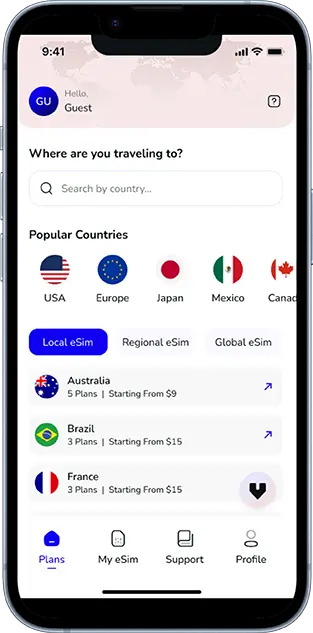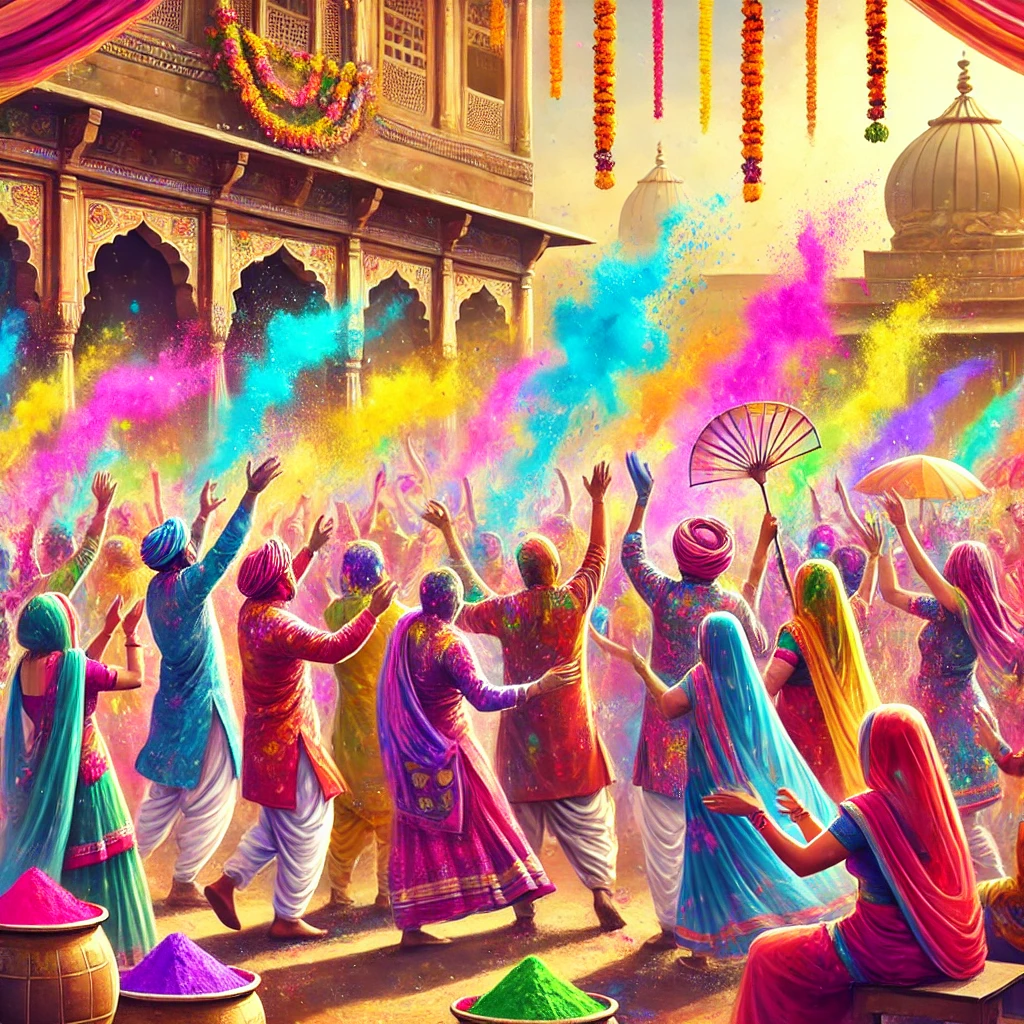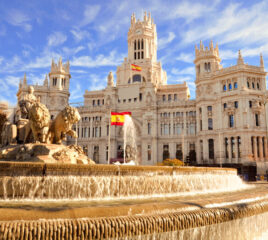Note that iPhone devices from Mainland China aren’t eSIM compatible. Also iPhone devices from Hong Kong and Macao aren’t compatible (except for iPhone 13 Mini, iPhone 12 Mini, iPhone SE 2020 and iPhone XS)
Holi, the festival of colors, is one of the most lively and joyous celebrations in India. It’s a time when people come together to throw colored powders, dance to music, and enjoy festive foods. But Holi is more than just a fun party—it’s a festival with deep roots and significant meaning. It marks the victory of good over evil and the arrival of spring. Families and friends gather to forgive past grievances, renew relationships, and celebrate life. Whether you’re in India or anywhere else in the world, Holi is a reminder of the power of love and unity.
The Origins and Legends of Holi
The Tale of Prahlad and Holika
One of the most famous legends associated with Holi is the story of Prahlad and Holika. Prahlad was a devout young prince who worshipped Lord Vishnu, much to the dismay of his father, the demon king Hiranyakashipu. Hiranyakashipu, who wanted everyone to worship him instead, plotted to kill his own son. He enlisted the help of his sister Holika, who had a magical cloak that protected her from fire. Holika tricked Prahlad into sitting on her lap in a bonfire, but miraculously the cloak flew off Holika and shielded Prahlad instead, burning Holika to ashes. This story symbolizes the triumph of good over evil and is celebrated during Holika Dahan, the night before Holi.
Krishna’s Playful Antics
Holi is also deeply connected with the playful antics of Lord Krishna, particularly his love for Radha. Young Krishna was known for his mischievous nature, especially when it came to playing pranks with the gopis (milkmaids) of Vrindavan. He was concerned about his dark complexion compared to Radha’s fair skin, so his mother Yashoda suggested he color Radha’s face with any color he liked. This playful act of applying colors became a joyful tradition, symbolizing love and friendship. Today, the vibrant festival of colors celebrates these playful stories of Krishna and Radha.
Symbolism of Good Over Evil
Holi is not just about colors and fun; it carries a deep symbolism of the victory of good over evil. The festival marks the end of winter and the beginning of spring, a time when nature itself seems to celebrate renewal and life. The bonfires of Holika Dahan represent the burning away of evil, making way for new beginnings. People come together, forgetting past grievances, and embrace each other in a spirit of forgiveness and renewal. Holi teaches us that, despite the challenges, goodness will always prevail in the end.
Holi, with its vibrant colors and joyous celebrations, reminds us of the power of love, unity, and the eternal triumph of good over evil. It’s a festival that brings people together, breaking down barriers and building connections.
Celebrate Holi Without Boundaries
Skip the roaming fees and focus on the celebration.
The Cultural Significance of Holi
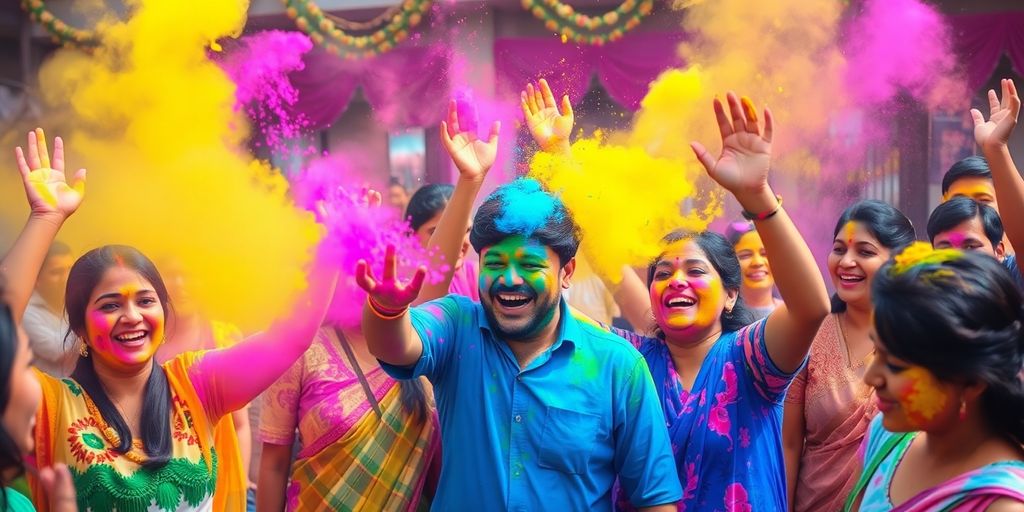
Community Bonding and Unity
Holi is more than just a burst of colors; it’s a time when people come together, forgetting all differences. During the festival, communities unite, transcending boundaries of age, caste, and creed. The spirit of Holi fosters a sense of togetherness as people gather in streets and homes, sharing laughter, music, and dance. It’s a time when everyone is equal, and friendships are renewed, creating an atmosphere of harmony and joy.
Preservation of Traditions
Holi is deeply rooted in Indian culture, and its celebrations help preserve age-old traditions. Families pass down stories and rituals from one generation to the next, ensuring that the cultural heritage remains alive. The playful antics of Lord Krishna, often recounted during Holi, serve as a storytelling experience that enriches these traditions. This festival is a living testament to the resilience of cultural practices that withstand the test of time.
Holi as a Storytelling Experience
The narratives associated with Holi, like the tales of Krishna and the victory of good over evil, are integral to the festival’s charm. These stories are shared among families and communities, enhancing the festive spirit. During Holi, storytelling becomes a vibrant part of the celebrations, connecting people to their roots and allowing them to relive the legends that give the festival its magical aura.
Holi is a vibrant festival that represents the victory of good over evil, marks the onset of spring, and fosters community and friendship among people. It’s not just about colors; it’s about embracing life with open arms and an open heart.
Traditional Rituals and Celebrations
Holika Dahan: The Bonfire Ritual
Holika Dahan kicks off the Holi festivities with a powerful bonfire ritual. This tradition symbolizes the triumph of good over evil, inspired by the legend of Prahlad and Holika. As night falls, people gather around the pyre, chanting prayers and singing songs. The flames are believed to purify the air and ward off evil spirits. It’s a time for families and friends to come together, sharing stories and laughter.
Playing with Colors: A Joyous Affair
The heart of Holi is the vibrant color play, where people of all ages smear each other with powdered hues. This playful exchange breaks down social barriers, making everyone equal in the spirit of joy. Streets and parks become a riot of colors, with shouts of “Bura na mano, Holi hai!” meaning “Don’t mind, it’s Holi!” ringing in the air. The colors are not just for fun; they hold symbolic meanings—red for love, green for new beginnings, and blue for the divine.
Music, Dance, and Festive Foods
Holi is not just about colors; it’s a full-blown celebration of life. Music and dance are integral, with people dancing to the beat of dhols and singing traditional songs. The air is filled with the aroma of delicious foods like gujiya, puran poli, and thandai. Families prepare these traditional dishes, adding a culinary delight to the festivities. It’s a time to indulge and enjoy, making memories that last a lifetime.
Holi is a festival that brings out the child in everyone, a time to let go of worries and embrace the joy of the moment. The rituals and celebrations are a testament to the rich cultural tapestry of India, inviting everyone to join in the vibrant dance of colors and traditions.
For more on how to explore the vibrant celebrations of Holi, check out our guide on essential traditions and rituals.
Modern-Day Celebrations and Global Influence
Holi Beyond India: A Global Festival
Holi, once a vibrant celebration confined to the Indian subcontinent, has now crossed borders and is celebrated with enthusiasm in many parts of the world. From the bustling streets of New York to the serene landscapes of New Zealand, the festival of colors has found a welcoming embrace. Communities come together, irrespective of their backgrounds, to throw colored powders, dance to lively music, and enjoy the joyous spirit that Holi brings. This global adaptation of Holi showcases how cultural traditions can transcend geographical boundaries, fostering a sense of unity and joy.
The Rise of Synthetic Colors
Traditionally, Holi was celebrated with natural colors made from flowers and herbs. However, the demand for brighter and more varied hues has led to the rise of synthetic colors. While these synthetic colors offer a broader palette, they also come with environmental and health concerns. Many people are now advocating for a return to organic colors, emphasizing not only the safety of participants but also the protection of nature. This shift is a reminder of the balance between modern convenience and traditional practices.
Holi in Popular Culture
Holi’s vibrant essence has been captured in various forms of popular culture. From Bollywood movies to international music festivals, the festival’s colorful and carefree spirit is celebrated and shared with a global audience. Films often depict scenes of Holi to symbolize joy, love, and new beginnings, making it a popular motif. Moreover, music festivals around the world have adopted the idea of color runs and parties, inspired by Holi, to create a unique and exhilarating experience for participants. This cultural exchange highlights Holi’s universal appeal and its ability to bring people together in celebration of life.
Experiencing Holi: Tips for Travelers
Safety and Precautions
Holi is a vibrant festival celebrated with large crowds, where participants often tread on each other’s feet amidst the festivities. It’s advisable to keep your toes covered to avoid discomfort during the celebrations. Here are some tips to ensure a safe experience:
- Opt for natural colors: Synthetic colors can irritate the skin. Choose organic options to avoid any allergic reactions.
- Protect your skin: Apply a generous amount of coconut oil or moisturizer to safeguard your skin from staining and dryness.
- Stay hydrated: With all the excitement, it’s easy to forget to drink water. Keep a bottle handy to avoid dehydration.
Participating in Holi can be a thrilling experience, but remember to take care of your safety and respect others’ boundaries.
Participating in Local Events
Joining local celebrations is the best way to experience Holi. Here are some ways to get involved:
- Community gatherings: Many neighborhoods host public Holi events that welcome visitors. These are perfect for experiencing the festival’s true spirit.
- Themed parties: Check out local clubs or resorts that host Holi parties with DJs and live music. These can be a fun way to celebrate with a modern twist.
- Cultural performances: Look for events featuring traditional music and dance, offering a glimpse into the rich cultural tapestry of Holi.
Must-Try Holi Delicacies
No Holi experience is complete without indulging in its delicious treats. Here are a few you shouldn’t miss:
- Gujiya: A sweet pastry filled with khoya and nuts. It’s a Holi staple!
- Thandai: A refreshing, spiced milk drink, often infused with almonds and saffron.
- Puran Poli: A sweet flatbread that’s particularly popular in certain regions.
Enjoying these delicacies is a delightful way to immerse yourself in the festive spirit of Holi.
The Spiritual and Emotional Impact of Holi
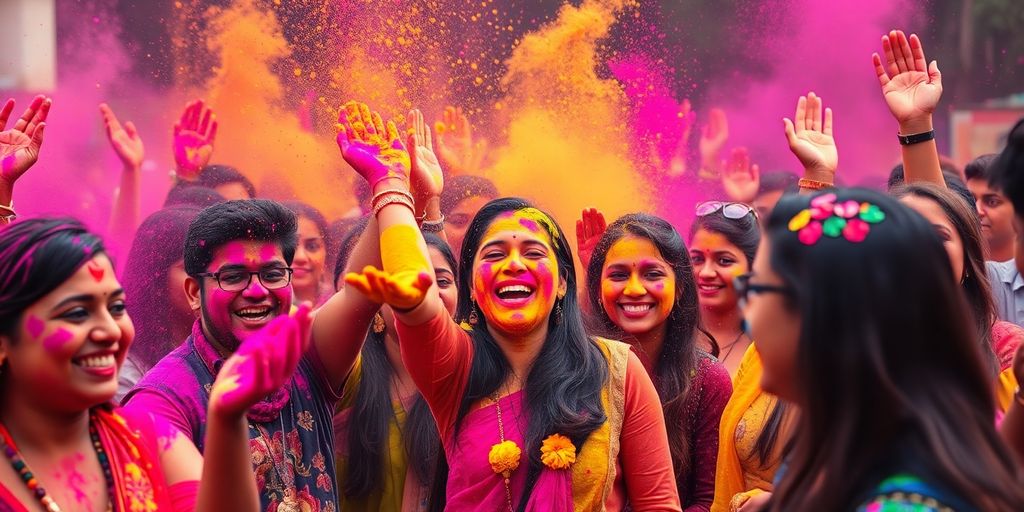
Embracing Forgiveness and Renewal
Holi is more than just a festival of colors; it’s a time for forgiveness and renewal. As people gather to celebrate, they let go of past grudges and embrace new beginnings. This act of forgiving those who may have wronged us is a powerful spiritual practice, fostering a sense of peace and harmony. It’s about wiping the slate clean and starting anew, much like the vibrant colors that wash away the dullness of winter.
The Joy of Letting Go
There’s something incredibly freeing about the chaos of Holi. The festival encourages participants to let go of their inhibitions, revel in the moment, and enjoy the simple pleasures of life. This joyous abandonment is a reminder to live in the present and appreciate the small things that bring happiness. It’s a time when laughter fills the air, and everyone, regardless of age, becomes a child again, lost in the playful spirit of the festival.
Holi as a Celebration of Life
Holi is a vivid celebration of life itself. The explosion of colors symbolizes the beauty and diversity of existence, urging everyone to cherish each moment. It’s a festival that transcends barriers, uniting people from different walks of life in a shared experience of joy and camaraderie. In the spirit of Holi, individuals come together to celebrate not just the festival, but life itself, fostering a sense of belonging and community. As mentioned in Holi, the Festival of Colors, this celebration enriches the social fabric through shared experiences and joyful connections.
Holi teaches us that life is a tapestry of emotions and experiences, each color representing a unique story. It’s a reminder that even amidst chaos, there is beauty to be found.
Conclusion
So, there you have it. Holi isn’t just about splashing colors and having a good time. It’s a festival that brings people together, breaking down barriers and spreading joy. It’s about celebrating the triumph of good over evil, welcoming the spring, and cherishing the bonds we share with family and friends. Whether you’re in India or anywhere else in the world, Holi is a reminder of the beauty of unity and love. So next time you see those vibrant colors, remember the stories and traditions that make Holi so special. Until then, keep the spirit of Holi alive in your heart, and spread the joy wherever you go.
Frequently Asked Questions
What is Holi and why is it celebrated?
Holi is a popular festival in India known as the festival of colors. It celebrates the victory of good over evil and marks the arrival of spring. People play with colored powders and water, dance, and enjoy festive foods.
What are the origins of Holi?
Holi’s origins are rooted in ancient Hindu mythology. One popular story is of Prahlad and Holika, which symbolizes the triumph of good over evil. Another tale involves the playful antics of Lord Krishna.
How is Holi celebrated in India?
Holi is celebrated over two days. The first day involves a bonfire called Holika Dahan. The second day is filled with fun as people throw colors, dance, and enjoy traditional sweets and drinks like Gujiya and Thandai.
Is Holi celebrated outside of India?
Yes, Holi is celebrated in many countries around the world, including the United States, the United Kingdom, and Australia. These celebrations often feature similar activities, like playing with colors and enjoying music and dance.
What are some safety tips for celebrating Holi?
To stay safe during Holi, use natural colors to avoid skin irritation, protect your eyes, and be mindful of your belongings in crowded areas. It’s also wise to wear old clothes as they might get stained.
What foods are commonly eaten during Holi?
During Holi, people enjoy a variety of traditional foods. Popular treats include Gujiya, a sweet pastry filled with nuts and dried fruits, and Thandai, a refreshing milk-based drink flavored with spices.
Explore Holi with Voye Global eSIM
Whether you’re celebrating the vibrant festival of Holi in India or joining festivities across the globe, staying connected with family, friends, and local events is essential. Voye Global eSIM lets you seamlessly stay in touch without the hassle of switching SIM cards or worrying about roaming fees. With reliable data and calls, you can immerse yourself fully in the joyful celebrations, capture every colorful moment, and share it instantly. Ready to make the most of your Holi experience? Let Voye Global eSIM keep you connected wherever you are.
Capture the Colors, Share the Moments
Keep sharing your festival memories without any interruptions.
Seamless Mobile Data Everywhere
